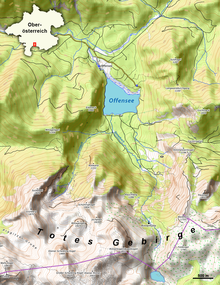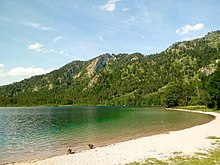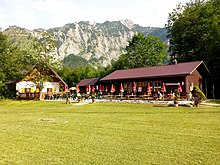Offensee
| Offensee | ||
|---|---|---|
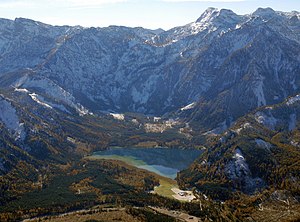
|
||
| View from the Eibenberg | ||
| Geographical location | Salzkammergut , Upper Austria , Markt Ebensee am Traunsee | |
| Tributaries | Rinnerbach | |
| Drain | Offenseebach | |
| Location close to the shore | Ebensee on the Traunsee | |
| Data | ||
| Coordinates | 47 ° 45 '12 " N , 13 ° 50' 17" E | |
|
|
||
| Altitude above sea level | 649 m above sea level A. | |
| surface | 55 ha | |
| length | 960 m | |
| width | 850 m | |
| volume | 10,500,000 m³ | |
| Maximum depth | 38 m | |
| Middle deep | 19 m | |
| PH value | 8.2 | |
| Catchment area | 20.61 km² | |
| Water renewal: 6 months | ||
The Offensee is a mountain lake in the Upper Austrian part of the Salzkammergut in the municipality of Ebensee am Traunsee , at the northern foot of the Dead Mountains and lies at 649 m above sea level. A. The course of the Offensee is the Offenseebach , which drains over the Traun into the Danube . The nutrient-poor lake, with its largely natural shores and the strongly structured vegetation belt with adjacent wetlands, offers habitats for many animal and plant species; the area has been a nature reserve since 1965. The Offensee is owned by the Austrian Federal Forests and is a popular swimming lake and excursion destination.
geography
The lake in the Salzkammergut , 7 km southeast of the center of Ebensee am Traunsee , can be reached via Offenseestraße L1296, which runs along the north bank. At the end of the street there are parking lots in the northwest and northeast. A forest road that is closed to public traffic leads around the lake.
The trapezoidal lake has a maximum length of 960 m and a maximum width of 850 m. The surface is about 57 hectares, the average depth 19 m. The lake basin has steep slopes except for the northern area. Only from a depth of about 35 m does the gradient gradually decrease and a relatively large soil zone with a maximum depth of 38 m spreads. The volume of water is 10.5 million cubic meters. The banks are mostly rocky and steep on the long sides and are dominated by the Eibeneck ( 1040 m above sea level ) in the west and the Gschirreck ( 1410 m above sea level ) in the east . The north and south banks are flat and run out in wide silting or grass zones.
Hydrology
The hydrological catchment area of the Offensee has a total area of 20.61 km². The lake is fed on the one hand from above-ground tributaries such as the Rinnerbach , which flows into the lake in the south, where it creates an alluvial cone. The Grünbach flows from the southwest to the Rinnerbach. These two streams very often dry out above ground. The often early ice melt in the confluence area and the comparatively lower water temperatures there in summer suggest that there is a permanent underground water inflow through the gravel body that forms the stream bed. The catchment area lies in a basin bounded by the steep northern slopes of the Weißhorn and the Rinnerkogel . In the north is the outlet of the Offenseebach. The lake runoff is regulated by an overflow weir from Energie AG , which is located on the Offenseebach around 500 meters north of the Offensee. The use of energy for the economy can result in water level fluctuations in the lake of up to 0.9 m. The water renewal time is around 6 months.
geology
tectonics
The Offensee lies on the border between the Totengebirgs blanket and the Staufen-Höllengebirgs blanket ( Tirolikum ) and is therefore part of the Northern Limestone Alps . This ceiling units consist predominantly of Mesozoic limestones and dolomites of the triad . In the western part of the Dead Mountains is the Schönberg Group, which is separated from the Priel Group by a geologically determined deep depression . This tectonic fault, known as the Wildensee line, runs from the Altausseer See over the Hochklapfsattel to the Wildensee and on over the Rinnerboden to the Offensee. The Eibeneck consists of main dolomite , the Gschirreck of Wetterstein dolomite . Rinnerkogel and Weißhorn consist of Dachstein limestone , with the main dolomite reaching up to Wildensee between these mountains.
Former glaciation and formation
During the Ice Ages, the Offense glacier flowed from the plateau of the Dead Mountains over the Offensee-Frauenweißbachtal west to the Traung glacier near Plankau. Due to the action of the glaciers, the deepened basin of the Offensee was created in the valley. In the postglacial, the basin was subject to a constant, heavy inflow of debris, which is the reason for the restriction of the once much larger lake area. The earlier extent can be recognized by the rock edges and the remnants of the edge moraine above the Offenseesäge weir system. The rubble was mainly fed in through the Grieseneckbach, which created a mighty alluvial cone in the north of the lake . The Rinnerbach dammed up behind it and the Offensee was created. This alluvial cone extends far into the lake area and forms the shallow water zone on the north bank, which ends with a steep drop. On the north-east bank, the tendency towards further silting is clearly visible.
climate
Due to the frequent cloud jams on the northern edge of the Dead Mountains , an above-average amount of precipitation falls in the catchment area of the Offensee. The annual precipitation averages 2291 mm, of which about 494 mm evaporates, the remainder of 1797 mm flows away. Around 55–60% of precipitation falls in summer. The wettest days are recorded in July, and July is also the wettest month. The annual average temperature is between 6 and 8 ° C.
Limnology
In the spring after the ice melts, the water body mixes and brings oxygen-rich water into the depths. In the summer half of the year, the surface layer in particular warms up; in autumn there is renewed mixing, which is followed by ice formation. There are weak stratification conditions in the Offensee. A thermal epilimnion forms (if at all) in summer only in the top 1–2 m. The average water temperature of the surface is 10 ° C. The minimum water temperature measured between 2012 and 2017 was 1.1 ° C, the maximum 21.8 ° C. A sharp drop in temperature is the rule from a depth of 3 m and this continues up to 6 m. Only below that does the temperature gradient flatten out . In summer, the temperature usually measures around 7 ° C in 20 m. As expected, the temperature above the ground is relatively constant. In 2007 and 2008 values between 4.4 and 6.0 ° C were measured. Even moderately warm summers cause a significant rise in temperature over the ground up to September.
The lake has a low concentration of nutrients and is therefore oligotrophic . Due to the low phytoplankton concentration and the low algae growth, the mean summer visibility is 11 meters. The phytoplankton community of the Offensee is dominated by representatives of the genus Cyclotella at all times of the year . The genus represents a relatively constant 40% of the biovolume on an annual average.
Flora and vegetation
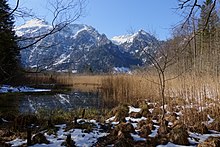
The steep west and east banks are covered by a mixed hillside forest, which is close to nature in the upper parts. The dominant tree species there are the common spruce ( Picea abies ), which is also reforested, the red beech ( Fagus sylvatica ) and the sycamore maple ( Acer pseudoplatanus ). In the north there is a small silting bog in which the stiff sedge ( Carex elata ) dominates. In front of the silting bog is a reed bed with a sparse population of reeds ( Phragmites australis ), common pond rush ( Schoenoplectus lacustris ) and beak sedge ( Carex rostrata ). In the eastern part of the siltation zone there are also black alder swamp forests . Inland are wet meadows with tall herb communities in which the Meadowsweet ( Filipendula ulmaria ) dominated. The road on the west bank with bank reinforcements prevents a near-natural bank development.
Chandelier algae , adapted to cold water, form the main part of the submerged vegetation and cover large parts of the lake floor. Extensive populations of Chara aspera can be found in the shallow water . Chara contraria and Chara virgata join at the bottom . Finally, there are also larger populations of Chara globularis . The lower macrophyte border is formed by the dark luster algae ( Nitella opaca ) at a depth of almost 20 m. The Canadian waterweed ( Elodea canadensis ) occurs in the shallow water of the southeast bay and along the steep drop of the shallow water zone on the north bank of the lake . The common fir frond ( Hippuris vulgaris ) occurs mainly in the underwater form in shallow water. The mountain clan of the hair-leaved water cockfoot ( Ranunculus trichophyllus ), which blooms under water, also thrives in the clear mountain water . The spawning herbs are represented by common dwarf pondweed ( Potamogeton pusillus ) and shimmering pondweed ( Potamogeton × nitens ).
The north bank and the silting moor are home to a species-rich moss flora. Noteworthy is a relatively large occurrence of the moss species Hamatocaulis vernicosus , which is protected by the Fauna-Flora-Habitat Directive . Base-loving mosses such as Calliergon giganteum and Scorpidium scorpioides occur in most of the moor and Campylium elodes on clumps on the bank area . The extremely rare Cinclidium stygium forms large populations locally in more open places . It is worth mentioning the appearance of Pseudocalliergon lycopodioides , which grows between large sedge groves. The Offensee is the third site of its kind in Austria.
fauna
Originally, as in most of the small, cold mountain lakes in the Dead Mountains, fish such as minnow ( Phoxinus phoxinus ), lake trout ( Salmo trutta ) and arctic char ( Salvelinus alpinus ) were predominant. In the Offensee the eel rod ( Lota lota ) is also autochthonous . The following fish species also occur through artificial stocking: pike ( Esox lucius ), carp ( Cyprinus carpio ), tench ( Tinca tinca ), roach ( Rutilus rutilus ) and perch ( Perca fluviatilis ). The silting zone on the north bank is an ideal spawning area for amphibians. Common frog ( Rana temporaria ) and common toad ( Bufo bufo ) are common. Also yellow-bellied toads ( Bombina variegata ) and Alpine newt ( Ichthyosaura alpestris ) live in Offensee.
In Offensee there is a dense population of noble crayfish ( Astacus astacus ), especially on the west bank . The Offensee has a special location due to the raging and steeply sloping Offenseebach, which protects against migrating signal crabs ( Pacifastacus leniusculus ) and interrupts the transmission chain of crayfish plague . The noble crayfish is not originally native to the lake and the population can be traced back to artificial stocking.
In addition to the common annual birds, the coot ( Fulica atra ) and mallard ( Anas platyrhynchos ), the great crested grebe ( Podiceps cristatus ) is one of the breeding birds at Lake Offensee.
natural reserve
With its diverse flora and fauna, the Offensee represents a relatively intact ecosystem and the area has been under nature protection since 1965 ( Offensee , N142 ). It includes the lake and the adjacent banks. The protected area is 58.8 hectares. The protected area is divided into three zones. Zone A includes the north bank and the quarry forest in the northeast. Entering and driving with boats is prohibited. Zone B is the upstream, shallow part of the lake. Driving on with boats is only permitted for fishing purposes and for the Austrian Federal Forests. Zone C includes the rest of the lake, where bathing and rowing boats are permitted. Occupation measures may only be carried out with the indigenous fish species minnow ( Phoxinus phoxinus ), lake trout ( Salmo trutta ), arctic char ( Salvelinus alpinus ) and eel rod ( Lota lota ). Stocking with pike ( Esox lucius ) requires the approval of the nature conservation authority. The protected area Offensee and the adjacent silting moor according to the FFH directive as part of the Natura 2000 network is slightly larger with 66 hectares than the protected area prescribed by the state of Upper Austria and also includes the silting bog on the north bank.
The large population of crayfish is of regional importance for the restocking of the surrounding lakes. In Laudachsee 2008, the crayfish plague occurred and destroyed the stock of crayfish. The Laudachsee was newly populated with crabs from the Offensee. In 2010, the population build-up in the Vorderen Langbathsee , consisting of 145 crabs from the Offensee, began.
To protect the amphibian population, the Ebensee Animal Welfare Association erects an amphibian fence along Offenseestrasse every year during spawning time .
economy
Forestry, hunting and fishing
The Offensee and the surrounding forests are owned by the Austrian Federal Forests and are managed as the Offensee forest district. The forests are used for forestry purposes and are criss-crossed by a network of forest roads. As the owner, the Federal Forests assign the hunting grounds to external hunting tenants. The fishery is leased to local fishing clubs.
Energy industry
The Offensee is used as storage for the storage power plant Offensee 1 and the subsequent power plant Offensee 2 of Energie AG . These were put into full operation by Stern & Hafferl in 1908 and 1909. Together with the Steeg power plant and the Traunfall plant , with which the Offensee power plants have been connected by a high-voltage line since they were commissioned , they formed the basis for the electrification of Upper Austria. In addition to the water from the Offenseebach, which can be regulated by controlling the flow of the lake, the power plants also use inflows from the neighboring Gimbach Valley . This generates around 20 GWh of electrical energy per year .
tourism
The Offensee is a popular excursion destination and is used as a bathing lake, especially in summer because of the pleasant surface temperature of the water. Large parts of the south bank are used as a lawn for sunbathing. The Seeau snack bar is located there . To the north of the lake, at the outlet, there is the Hauseck shelter. The Offensee is also suitable for ice skating or ice stock sport , as it often freezes over completely in winter .
The Offensee is the starting point for several hiking trails:
- Riverside path around the lake
- Path 420: The high path connects the lake with the Almsee and is part of the Voralpenweg 04 .
- Path 422: It runs north into the Rindbachtal and is part of the Voralpenweg 04.
- Path 212: Offensee - Rinnerhütte - Wildensee - Altaussee
history
The Offensee area used to belong to the Traunkirchen nunnery . Field names such as Frauenweißbach indicate this. With the construction of the nearby saltworks in Ebensee am Traunsee in 1604, the entire timber industry in the area was geared towards producing firewood for the brewhouse . The Frauenweißbach-Offenseebach valley was also developed for timber transport. As on the lakes of the inner Salzkammergut, there was also a hermitage to the wood drift at the outflow of the Offensee . From the wooden Offenseeklause it was reported in 1666 that all four gates were rotten and therefore had to be replaced. In 1887 floods destroyed most of the Trift buildings. The Holztrift was then on the run. Forest roads were built later, on which the wood was transported by horse and cart. From 1909 to 1954 there was the Offenseebahn, a forest railway for bringing wood.
North of the lake at the outlet is the Offensee hunting lodge , a former hunting lodge of Emperor Franz Joseph I. The ensemble of buildings with chapel is kept in classic Schönbrunn yellow . The hunting lodge housed a lung sanatorium from 1920. In the children's sanatorium set up by Emil Kugler , mainly children with bone tuberculosis were treated with sun therapy. Today the hunting lodge serves as apartment accommodation.
literature
- Office of Upper Austria. Provincial government, Environment and Water Management Department, Surface Water Management Department (Ed.): Lake Authority in Upper Austria - Water Protection Report 43 . Linz July 2010 ( land-oberoesterreich.gv.at [PDF; 24.5 MB ; accessed on November 24, 2020]).
- Office of Upper Austria. Provincial government, nature conservation department (ed.): Nature and landscape / models for Upper Austria. Volume 32: Salzkammergut-Voralpen spatial unit . Linz September 2007 ( land-oberoesterreich.gv.at [PDF; 4.7 MB ; accessed on November 24, 2020]).
- Engelbert Koller: 350 years of the Ebensee saltworks. In: Oberösterreichische Heimatblätter, Linz 1957, PDF in the forum OoeGeschichte.at
Web links
Individual evidence
- ↑ a b c d e Seeprofil Offensee (PDF; 1.1 MB) In: Official-Seen-Messnetz . Office of the Upper Austrian Provincial Government, Environment and Water Management Department, Surface Water Management Department. October 2013. Accessed November 24, 2020.
- ↑ a b c Office of Upper Austria. Provincial government: nature and landscape / models for Upper Austria. Volume 32: Salzkammergut-Voralpen spatial unit. Pp. 22-23.
- ↑ Geological Federal Institute (ed.): Geological map of Upper Austria 1: 200,000 . Vienna 2006 ( geologie.ac.at [PDF; accessed on January 27, 2021]).
- ↑ a b University of Natural Resources and Life Sciences - Institute for Alpine Natural Hazards and Forest Engineering: Documentation and basic survey for processing the flood events of August 2002 in the area of the WLV regional construction management Salzkammergut . Ed .: Forest technology service for torrent and avalanche control, regional construction management Salzkammergut, Upper Austria section. Vienna 2003 ( boku.ac.at [PDF; accessed on January 27, 2021]).
- ^ Hermann Kohl: The Ice Age in Upper Austria. Part II: The Ice Age glaciation in Upper Austria. In: Yearbook of the Upper Austrian Museum Association, 143a (1998), especially chap. 7 The area of the ice age glaciers of the Steyr and Kremstal valleys, p. 313 ff., Full article p. 175–390 ( online (PDF; 52.6 MB) on ZOBODAT ; there p. 257 ff.).
- ^ Office of Upper Austria. Provincial government: lake supervision in Upper Austria - water protection report 43. p. 160.
- ^ Office of Upper Austria. Provincial government: lake supervision in Upper Austria - water protection report 43. p. 161.
- ^ Office of Upper Austria. State government, nature conservation department (ed.): Structure mapping Offensee (biotope areas) . Linz 1993 ( land-oberoesterreich.gv.at [PDF; accessed on November 24, 2020]).
- ↑ a b Office of Upper Austria. State government, nature conservation department (Ed.): Macrophyte mapping Offensee . Linz June 2016 ( land-oberoesterreich.gv.at [PDF; accessed on January 27, 2021]).
- ↑ Christian Schrock, Heribert Köckinger, Gerhard Schlüsslmayr: Catalog and Red List of bryophytes of Upper Austria . In: Botanische Arbeitsgemeinschaft am O.Ö. Landesmuseum Linz (ed.): STAPFIA . tape 100 . Linz 2014, p. 19 ( online (PDF) on ZOBODAT [accessed November 24, 2020]).
- ↑ a b Ordinance NSG Offensee. In: Federal Legal Information System (RIS). Retrieved January 28, 2021 .
- ^ Offensee district. In: VÖAFV - Association of Austrian Workers' Fishing Associations. Retrieved January 28, 2021 .
- ↑ Florian Cervicek: Crayfish in Upper Austria . Ed .: Office of Upper Austria. State government, nature conservation department. Schleissheim 2002, p. 13 ( land-oberoesterreich.gv.at [PDF; accessed on January 27, 2021]).
- ↑ Susanne Stadler, Norbert Pühringer: Ornithological observations from Upper Austria from 2003 . In: Province of Upper Austria, Upper Austrian Provincial Museum, Biology Center (ed.): Ornithological news from Upper Austria, current nature conservation . 12b. Linz 2004 ( online (PDF) at ZOBODAT [accessed on January 29, 2021]).
- ↑ Offensee nature reserve. In: Geographical Nature Conservation Information System (GENISYS). State of Upper Austria, accessed on November 24, 2020 .
- ^ Offensee and adjacent silting moor (FFH area, AT3143000). In: Geographical Nature Conservation Information System (GENISYS). State of Upper Austria, accessed on November 24, 2020 .
- ↑ Werner Weißmair, Clemens Gumpinger: Species protection project Edelkrebs Upper Austria (Astacus astacus) . Ed .: Office of Upper Austria. State government, nature conservation department. Neuzeug, Wels 2010 ( zobodat.at [PDF; accessed on January 27, 2021]).
- ↑ Amphibious fence erected on the road to Offensee. In: Salzkammergut district circular show. Retrieved January 6, 2021 .
- ↑ Oliver Rathkolb, Hannes Leidinger, Richard Hufschmied, Andreas Kuchler: Wasserkraft. Electricity.society . 2012, p. 39 .
- ↑ Overview of hydropower plants and subscription rights. In: energie.at. Retrieved November 24, 2020 .
- ↑ Koller, Engelbert: 350 years of the Ebensee saltworks . P. 85.


